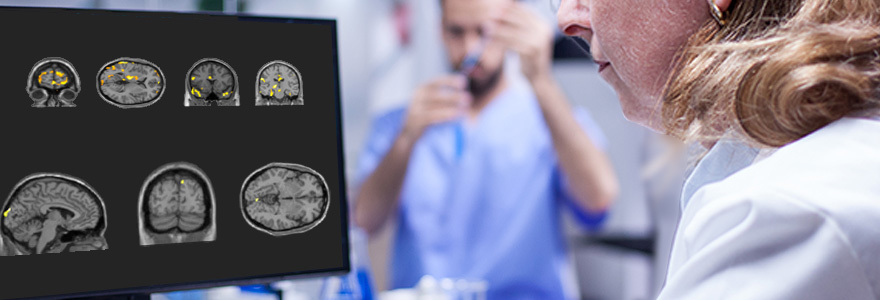Feature: Research reveals new paradigm for treating PTSD
 By Dika Ojiakor
By Dika Ojiakor
When Dr. Ruth Lanius, PhD, won her Grade 12 biology award in high school, she had no idea it would change the course of her life.
The award was a book about the brain, which became the catalyst for a career as a psychiatrist and neuroscientist. This led her to an undergraduate degree in biological psychology, and then a combined MD/PhD degree in neuroscience.
After medical school, and still captivated by the workings of the brain, Lanius started her residency in neuropathology where she spent time with traumatized individuals, an experience that led her to switch to psychiatry.
Now, as a Professor of Psychiatry at Schulich Medicine & Dentistry and the director of the post-traumatic stress disorder (PTSD) research unit at Western University, Lanius is developing neuroscientifically guided treatments for patients suffering from PTSD.
During her psychiatry residency, Lanius began to understand what happens when individuals recall traumatic memories and was intrigued by the different ways the brain responds to trauma and stress. While some of her traumatized patients displayed too much emotion and arousal, others had the opposite problem – they were emotionally shut down. These different experiences formed the basis for some of her early studies, in which she mapped out the brain under different trauma response conditions.
Adapting to the intolerable
PTSD is a mental and behavioral disorder that occurs when an individual experiences a traumatic event, often leading to persistent flashbacks and severe anxiety, even in the absence of threat. Approximately nine per cent of Canadian adults will experience PTSD in their lifetimes.
Most individuals who suffer from PTSD present with the classic form of the disorder, in which they display an excess of arousal and emotionality in response to fearful stimuli. However, a subset of individuals – about 14-30 per cent of all patients – present with symptoms often associated with emotional numbing and blunted arousal. This is known as the dissociative subtype of PTSD and leads to changes in brain activation that are often opposite to what is observed in classic PTSD.
“I think it’s a way the brain adapts to the intolerable when emotions and arousal become too intense, and the brain, mind, and body can no longer bear it,” said Lanius. “At the time of the trauma, this shutdown and detaching from your emotions is an amazing survival strategy.”
But in the long term, this emotional detachment may interfere with a person’s physical, psychological, and emotional well-being, such as feeling love for partners or children. The resulting guilt can be debilitating.
These different symptomatic profiles have led Lanius to develop a new paradigm for understanding post-traumatic stress, one that is centered on sensory processing.
Intervening at the reptilian level
Sensory processing, as described in a recent paper by Lanius and her team, refers to the ability to register, modulate, and organize incoming sensory information from one’s internal and external worlds, which in turn guides our response to internal and external stimuli. Lanius and her research team believe that incorporating sensory processing into how PTSD is understood is critical to its treatment.
“Trauma is experienced through sensory input – it is really an insult to your senses,” said Lanius. “While you see something horrible, you may also hear somebody insulting you, or experience the smell of alcohol. All this sensory information is registered at the level of the reptilian brain. To increase survival, this part of the brain takes over and reacts without thinking. That’s how we survive trauma.”
However, in the aftermath of trauma, the reptilian brain often becomes overreactive and dominates higher-order cognitive functions, which offer too slow a response to effectively deal with the trauma.
So far, the research team has worked on developing two different treatments to reduce symptoms in PTSD, one of which is neurofeedback, also called ‘brain training,’ which allows for individuals to regulate their own brain activity. A recent study examining this new therapy found its remission rate to be comparable to gold-standard therapies like trauma-focused psychotherapy.
“I think we need to ask the question: How can we intervene at those lower reptilian levels that mediate the arousal, raw affect and defensive responses? Often patients in the clinic tell us: ‘I know it wasn’t my fault’, or ‘I know I’m not a bad person, but I can't stop feeling it.’ I think this is that reptilian brain that carries trauma-related arousal and raw emotion, which is still affected by the trauma. And that’s where we really need to intervene when mainstream therapies are not effective.”
If you are interested in participating in one of Dr. Lanius' PTSD studies, please contact Suzy.Southwell@lhsc.on.ca








